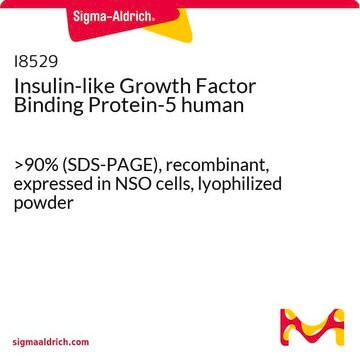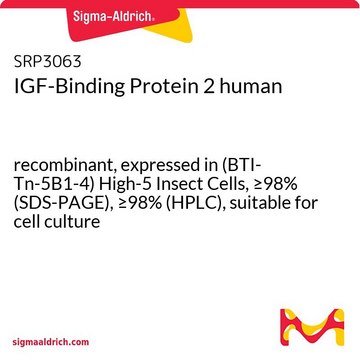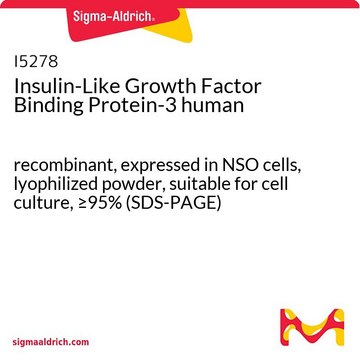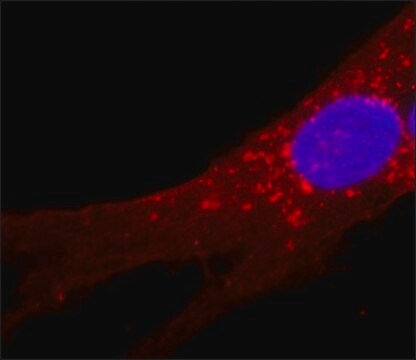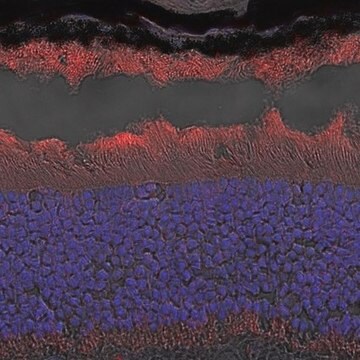SRP3068
IGF-Binding Protein-5 human
recombinant, expressed in E. coli, ≥98% (SDS-PAGE), ≥98% (HPLC), suitable for cell culture
Synonym(s):
IBP-5
Sign Into View Organizational & Contract Pricing
All Photos(1)
About This Item
UNSPSC Code:
51111800
NACRES:
NA.32
Recommended Products
biological source
human
recombinant
expressed in E. coli
Assay
≥98% (HPLC)
≥98% (SDS-PAGE)
form
lyophilized
potency
≤0.3 μg/mL
mol wt
28.6 kDa
packaging
pkg of 25 μg
technique(s)
cell culture | mammalian: suitable
impurities
<0.1 EU/μg endotoxin, tested
color
white to off-white
UniProt accession no.
shipped in
wet ice
storage temp.
−20°C
Gene Information
human ... IGFBP5(3488)
General description
IGFBP5 (insulin-like growth factor-binding protein 5) belongs to the IGFBP family of proteins. IGFBPs are mainly required to regulate IGFs (insulin like growth factors) activities. The gene IGFBP5 is mapped to human chromosome 2q35.
Recombinant human IGF-BP5 is a 28.6kDa protein consisting of 253 amino acid residues.
Recombinant human IGF-BP5 is a 28.6kDa protein consisting of 253 amino acid residues.
Biochem/physiol Actions
IGFBP5 (insulin-like growth factor-binding protein 5) works via IGF (insulin like growth factor)-dependent and -independent mechanisms. It can function as a tumor suppressor as well as an oncogene. Changes in the activity of this gene are often observed in human cancers and metastatic tissues. During cancer development, IGFBP5 is involved in cell growth, migration and invasion. IGFBP5 is associated with breast cancer, osteosarcoma, head and neck squamous cell carcinoma, neuroblastoma, prostate cancer and malignant melanoma. It is upregulated in systemic sclerosis and idiopathic pulmonary fibrosis. In primary fibroblasts, IGFBP5 exhibits pro-fibrotic effects. It is strongly expressed in bones and is involved in osteogenic differentiation. Under in vitro conditions, IGFBP5 and its microRNA (microRNA-143-3p) are involved in muscle regeneration.
Sequence
MLGSFVHCEP CDEKALSMCP PSPLGCELVK EPGCGCCMTC ALAEGQSCGV YTERCAQGLR CLPRQDEEKP LHALLHGRGV CLNEKSYREQ VKIERDSREH EEPTTSEMAE ETYSPKIFRP KHTRISELKA EAVKKDRRKK LTQSKFVGGA ENTAHPRIIS APEMRQESEQ GPCRRHMEAS LQELKASPRM VPRAVYLPNC DRKGFYKRKQ CKPSRGRKRG ICWCVDKYGM KLPGMEYVDG DFQCHTFDSS NVS
Physical form
Lyophilized from 10 mM Sodium Citrate, pH 3.0.
Reconstitution
Centrifuge the vial prior to opening. Reconstitute in water to a concentration of 0.1-1.0 mg/ml. Do not vortex. This solution can be stored at 2-8°C for up to 1 week. For extended storage, it is recommended to further dilute in a buffer containing a carrier protein (example 0.1% BSA) and store in working aliquots at -20°C to -80°C.
Storage Class Code
11 - Combustible Solids
WGK
WGK 3
Flash Point(F)
Not applicable
Flash Point(C)
Not applicable
Choose from one of the most recent versions:
Certificates of Analysis (COA)
Lot/Batch Number
Don't see the Right Version?
If you require a particular version, you can look up a specific certificate by the Lot or Batch number.
Already Own This Product?
Find documentation for the products that you have recently purchased in the Document Library.
IGFBP-5 Promotes Fibrosis Independently of Its Translocation to the Nucleus and Its Interaction with Nucleolin and IGF.
Su Y, et al.
PLoS ONE, 10, e0130546-e0130546 (2015)
Dervis A M Salih et al.
Proceedings of the National Academy of Sciences of the United States of America, 101(12), 4314-4319 (2004-03-11)
The insulin-like growth factors (IGFs) are essential for development; bioavailable IGF is tightly regulated by six related IGF-binding proteins (IGFBPs). Igfbp5 is the most conserved and is developmentally up-regulated in key lineages and pathologies; in vitro studies suggest that IGFBP-5
Alison J Butt et al.
The Journal of biological chemistry, 278(32), 29676-29685 (2003-06-05)
The role of insulin-like growth factor-binding protein (IGFBP)-5 in human breast cancer cell growth is unclear. We determined the effects of IGFBP-5 expression on the growth of human breast cancer cell lines in vivo and in vitro. Expression of IGFBP-5
Age-related changes in miR-143-3p:Igfbp5 interactions affect muscle regeneration.
Soriano-Arroquia A, et al.
Aging Cell, 15, 361-361 (2016)
Maya Ghoussaini et al.
Nature communications, 4, 4999-4999 (2014-09-24)
GWAS have identified a breast cancer susceptibility locus on 2q35. Here we report the fine mapping of this locus using data from 101,943 subjects from 50 case-control studies. We genotype 276 SNPs using the 'iCOGS' genotyping array and impute genotypes
Our team of scientists has experience in all areas of research including Life Science, Material Science, Chemical Synthesis, Chromatography, Analytical and many others.
Contact Technical Service